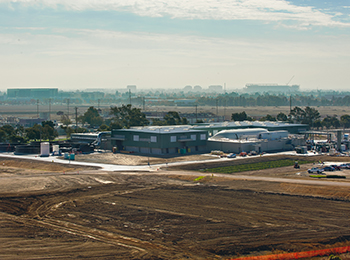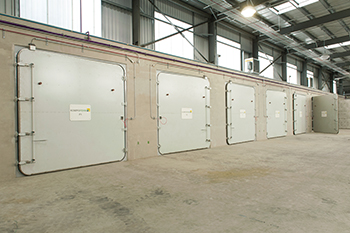New Technology Supports San Jose’s Green Vision
 SAN JOSE, Calif. — The city of San Jose has transformed its processing of organic wastes with the opening of the world’s largest dry fermentation anaerobic digestion facility.
SAN JOSE, Calif. — The city of San Jose has transformed its processing of organic wastes with the opening of the world’s largest dry fermentation anaerobic digestion facility.
The facility, which officially opened Nov. 22, will convert an estimated 90,000 tons of commercial organic waste, which would have been sent to landfill, into approximately 1.6 MW of renewable energy and 32,000 tons of compost. The facility is owned and operated by the Zero Waste Development Company and Zero Waste Energy (ZWE) developed the anaerobic digestion (AD) technology. The enclosed facility, which is aiming for LEED Gold certification, includes 16 ADs and four in-vessel composting tunnels.
The facility’s AD technology, Smartferm AD, speeds up decomposition by bringing the organic waste up to a range of 125 to 131 degrees in an oxygen-free environment, which allows bacteria to penetrate through the system, according to Dirk Dudgeon, senior vice president of business development with ZWE.
“As the organic waste decomposes in the digesters, the biogas being produced is captured. The gas is then cleaned to remove anything that would be bad for the engine,” Dudgeon said.
The produced biogas is then either converted to heat and electricity via a heat and power engine or to compressed natural gas (CNG) fuel. Because the AD is dry, the moisture content of the technology is much lower than traditional wet ADs. The energy production of the wet systems is less efficient, more labor-intensive and requires high water content, resulting in sludge that must then be disposed, according to Dudgeon.
“Not only will the system maximize the efficiency of its organics to produce energy and compost, but it will also move the city closer to its Green Vision Goal of Zero Waste to Landfill and Energy from Waste by its 2022 target,” Dudgeon said.
San Jose’s Green Vision consists of 10 goals. The implementation of AD technology and the opening of the facility are set to advance the city in its 15-year plan through reduced landfill waste and the generating of renewable energy. The system will also achieve the California Global Warming Solutions Act mandate.
Rising Popularity
ZWE’s first dry AD project at the Monterey Regional Waste Management District was completed in January 2013. It processes approximately 5,000 tons of organic waste per year and generates 100 kW of electricity, which is sold to the neighboring Monterey Regional Water Pollution Control Agency. The company has witnessed growing interest in dry AD technology and in this year alone ZWE has broken ground on four dry AD facilities.
“Dry AD has recently come to the forefront of the organic waste processing industry,” Dudgeon said.
 The flexible technology can be implemented in communities, waste management districts, universities and corporate campuses. Specifically, the Smartferm technology is scalable to meet the needs of facilities that process 4,000 to 100,000 tons of organic waste annually, Dudgeon said. Smartferm also controls odor and generates high-quality compost that can be sold, adding an economic boost to the local community.
The flexible technology can be implemented in communities, waste management districts, universities and corporate campuses. Specifically, the Smartferm technology is scalable to meet the needs of facilities that process 4,000 to 100,000 tons of organic waste annually, Dudgeon said. Smartferm also controls odor and generates high-quality compost that can be sold, adding an economic boost to the local community.
AD systems have widely been used in Europe. The continent is home to more than 8,000 AD installations with about 25,000 planned by 2020, according to the German Biogas Association. However, Dudgeon expects that the U.S. market will continue to see significant growth.
“The popularity of AD systems is expected to grow as legislation increasingly mandates higher waste diversion rates. Given that organic waste can be as much as 60 percent of landfill waste, organics becomes an increasingly important focus for many in the waste industry,” he said.
